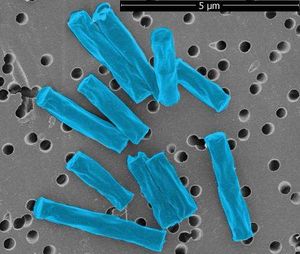Methanosaeta
Classification
Domain: Archaea Phylum: Euryarchaeota Class: Methanomicrobia Order: Methanosarcinales Family: Methanosaetaceae Genus: Methanosaeta
Description
The first culture of Methanosaeta was enriched in 1983 from thermal lake mud by Nozhevnikova et. al.[2] Methanosaeta is a methane producer, that specializes in only using acetate for methane production. Some species of this genus have been isolated as a pure culture [3]. The organism is most closely related to Methanosarcina, a genus of Archea capable of methanogenesis from other carbon sources besides acetate including carbon dioxide and hydrogen gas [4]. In general, members of this genus grow very slowly and can be difficult to culture [5]. Methanosaeta are gram negative rods typically .8 - 1.3 by 2 - 6 µm in size [6]
Ecology and Significance
These organism are widely distributed across the planet, and have an extremely high affinity for acetate allowing them to thrive even if concentrations are very low. They are commonly found in rice paddies and anaerobic digestors which are common sources of methane. I found it interesting that this genus has been speculated to be the principle methane producer on earth. This fact has made Methanosaeta the subject of many studies [7].
Genome Structure
The genome of Methanosaeta concilii and Methanosaeta thermophila have been fully sequenced. The genome of M. concilii is 3,008,626 base pairs in size, a GC content of 43.19% compared to the M. thermophila genome which is 1,861,571 base pairs with a GC content of 53.55%. There is poor gene overlap between these two species, consistent with the phylogenetic diversity between the two species. 50% of the predicted proteins in the M. concilii genome are not shared with M. thermophila. This means that these genomes have evolved by gene acquisition via lateral gene transfer or gene duplication in M. concilii, gene loss in M.thermophila, or possibly through a combination of these [8]. Methanosaeta is closely related to two groups of anaerobic methane-oxidizing Archea. Methanosaeta also has genes for carbon dioxide reduction; thus it is possible that Methanosaeta species could perform methane oxidation (7).
Additional Content
Methanosaeta is a symbiont of Metopus es and was the first acetoclastic methanogen observed as a symbiont. Metopus es was shown to produce acetate which is likely used by Methanosaeta for the production of methane [9].
With the recent finding of carbon dioxide reduction pathways, the metabolic diversity of Methanosaeta is likely much greater than the obligate acetoclasic methane producing organism it was once thought to be (7).
References
1) "Methanosaeta." NCBI Taxonomy Browser. U.S. National Library of Medicine. Web. 11 May 2015. <http://www.ncbi.nlm.nih.gov/Taxonomy/Browser/wwwtax.cgi?mode=Info&id=2222>.
2) Kamagata, Y., & Mikami, E. (1991). Isolation and characterization of a novel thermophilic Methanosaeta strain. International journal of systematic bacteriology, 41(2), 191-196.
3) Zinder, S. H., Anguish, T., & Lobo, A. L. (1987). Isolation and characterization of a thermophilic acetotrophic strain of Methanothrix. Archives of microbiology, 146(4), 315-322.
4) Narihiro, T., Terada, T., Ohashi, A., Wu, J. H., Liu, W. T., Araki, N., ... & Sekiguchi, Y. (2009). Quantitative detection of culturable methanogenic archaea abundance in anaerobic treatment systems using the sequence-specific rRNA cleavage method. The ISME journal, 3(5), 522-535.
5) Methanosaeta concilii GP6. (n.d.). Retrieved May 11, 2015, from http://bacmap.wishartlab.com/organisms/1322#biography
6) Kamagata, Y., Kawasaki, H., Oyaizu, H., Nakamura, K., Mikami, E., Endo, G., ... & Yamasato, K. (1992). Characterization of three thermophilic strains of Methanothrix (“Methanosaeta”) thermophila sp. nov. and rejection of Methanothrix (“Methanosaeta”) thermoacetophila. International journal of systematic bacteriology, 42(3), 463-468.
7) Smith, K. S., & Ingram-Smith, C. (2007). Methanosaeta, the forgotten methanogen?. Trends in microbiology, 15(4), 150-155.
8) Barber, R. D., Zhang, L., Harnack, M., Olson, M. V., Kaul, R., Ingram-Smith, C., & Smith, K. S. (2011). Complete genome sequence of Methanosaeta concilii, a specialist in aceticlastic methanogenesis. Journal of bacteriology, 193(14), 3668-3669.
9) Narayanan, N., Krishnakumar, B., Anupama, V. N., & Manilal, V. B. (2009). Methanosaeta sp., the major archaeal endosymbiont of Metopus es. Research in microbiology, 160(8), 600-607.
Figure 1: http://phys.org/news/2013-11-microbiologists-reveal-unexpected-properties-methane-producing.html
Author
Page authored by James Kralj, student of Prof. Katherine Mcmahon at University of Wisconsin - Madison.

